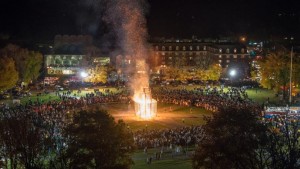The College on the Hill boasts many illustrious storied, and sordid traditions. The “Old Traditions” of Dartmouth have been a common thread between generations of students and are part of what makes community so close. Tales of Dartmouth night, first year trips, and winter carnival have been some of the many traditions that have connected members of the Dartmouth family young and old. As Dartmouth grows and changes, traditions change, fade, or even disappear. Many of these rituals have now been relegated to the history books. We at The Review are concerned by the fading of “Old Dartmouth” and would like to highlight a few traditions that are on life support.
One of Dartmouth’s most famous rituals is the homecoming bonfire. First lit in 1888 to celebrate a smashing baseball victory over Manchester, the Dartmouth Night bonfire has served as the crown jewel of Homecoming weekend for alumni and students alike. Since its inception, students have been pushing the limits of safety (and security) in hopes of being woven into this larger than life tale. First years looking to make a name for themselves on campus have been attempting to touch the bonfire for years, dodging S&S and Hanover Police officers alike along their dash to glory. This is a surprisingly new part of Dartmouth Night.
“I don’t remember trying to touch the fire in ‘88, but one of my friends tried to light a cigarette on it” wrote in an anonymous alumnus to Dartblog.org. “The attempt, which I think was successful, melted the sleeve of his bright yellow Patagonia jacket. He wore that jacket all four years. The Class Historians even made a joke about him at Class Day in ‘92.”
Classes who failed to touch the fire were dubbed the “worst class ever” by upperclassmen across campus. However, in recent years the administration has made a point to discourage freshmen from staring fear in the face, increasing penalties and ramping up anti-fire touching propaganda. In 2016, the fire was put out early because an overwhelming number of 20’s were touching the fire and the safety concerns became too great. In response, Phil Hanlon and the administration erected the “Hanover Wall” surrounding the bonfire. This chain link fence proved to be no match for the Class of 2021 as several freshmen scaled the fence on the way to Dartmouth glory.
“I’m a kid from Minnesota who went to an all-boys catholic military high school that also had many, many strong traditions that students tried fearlessly to uphold” said fire toucher Thor “Will” Mayleben ’21. “I couldn’t let down my classmates and alums here at Dartmouth.”
With penalties levied against fire touchers reaching up into suspensions, it remains to be seen whether every subsequent class to the ‘21s will be the worst class ever. Fire touching is certainly not dead, but it very well may be on its last legs.
The construction of the bonfire is also a quintessential piece of the event that makes it such a central part of Dartmouth. The bonfire used to be constructed exclusively by students, so much so that it was a competition between classes to see who could construct the largest. That is of course until the great class of ’79 erected a 100-tier wooden tower which attendees claim burned so hot it drove people off of the green entirely. The school later made a rule limiting the bonfire height, but the bonfire remains a student project.
Today, the pyre’s construction is largely managed by Buildings and Grounds employees and engineers due to safety concerns. Many of the newer safety provisions surrounding the bonfire can be linked to an accident in 1999 at Texas A&M University where a student built bonfire collapsed before being lit, killing several surrounding students.
“It was the Texas A&M collapse that changed the shape of the bonfire,” wrote Former Hanover Police Chief Nick Giaccone to Dartblog.org. “and also made changes in how College staff assisted in its construction. No longer would it be just freshman.”
Though it is understandable that the safety of the general public should not be solely left up to a group of 18 year olds, the college involvement in the process proved to be overbearing. As a result, the building of the bonfire is no longer a bonding activity but rather an afterthought. Though students are still able to take part in the bonfire’s construction, the comradery and class spirit that accompanied the undertaking are all but gone.


Be the first to comment on "Endangered Traditions: Touching the Fire"